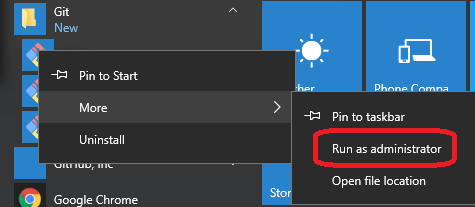...
The installer lets you choose the experimental 'difftool'; either choice will work. Continue with the installation dialogs until the installation is complete.
Windows Setup for git-review
Follow those steps if you are a Windows user and need to interact with Gerrit; it will help you when you install git-review on your system.
Preliminary Step: Install Putty and Generate a Putty Key
NOTE: If you already have keys registered with putty, skip this section.
- Ensure you have the complete putty suite installed. You should have pageant.exe, plink.exe and puttygen.exe.
- Generate a key with puttygen. Choose a passphrase, then select "Save private key" and choose a target; also "Save public key" and select a target. It is recommended to use file names containing "private" and "public" for the keys as both will end in .ppk.
- Start pageant if not started, then add your newly generated private key.
- Under the control panel > system > advanced system properties > environment variables, add a GIT_SSH entry (if not present) and point to plink.exe.
- When done, start a command line (cmd.exe) and run 'env'; the newly added environment variable should appear.
- In your Gerrit profile, add the public key. Also, copy/paste the known_hosts entries listed, into a file named known_hosts under your .ssh profile (something like C:\Users\<my-id>\.ssh) (if known_hosts does not exist, create it).
Install Python
...
on Windows
Download Python version 2.7.10:
...
Continue with the installation until it is completed.
Set up git review
Run Git Bash as Administrator (for example, in Windows 10, use the Windows menu, scroll to the Git directory, right-click on Git-bash, and select "Run as administrator":
Within Git -bashBash, type the following command:
...
| Info |
|---|
The git and git-review installation steps above are described derived from the description at: https://www.mediawiki.org/wiki/Gerrit/git-review#Windows |
...
NOTE: When entering the proxy username, you might be required to add the domain name in front of the username.
Install Putty on Windows and Generate a Public Putty Key
NOTE: If you already have keys registered with putty, skip this section.
- Ensure you have the complete putty suite installed. You should have pageant.exe, plink.exe and puttygen.exe.
- Generate a key with puttygen. Choose a passphrase, then select "Save private key" and choose a target; also "Save public key" and select a target. It is recommended to use file names containing "private" and "public" for the keys as both will end in .ppk.
- Start pageant if not started, then add your newly generated private key.
- Under the control panel > system > advanced system properties > environment variables, add a GIT_SSH entry (if not present) and point to plink.exe.
- When done, start a command line (cmd.exe) and run 'env'; the newly added environment variable should appear.
- Copy/paste the known_hosts entries listed, into a file named known_hosts under your .ssh profile (something like C:\Users\<my-id>\.ssh) (if known_hosts does not exist, create it).
You will need the above-generated public key in order to set up your connection method with the Gerrit host, described next.
Selecting a connection method
...
Once Git /Gerrit is installed, you will need to select a connection method to the remote serverGerrit host, https://gerrit.openecomp.org/.
We recommend using SSH, in which case you need to register your public key in your account settings on the Gerrit host.
SSH Connection (Recommended)
Log in to the Gerrit host https://gerrit.openecomp.org/, pull down the menu under your user name (at the extreme top right of the browser window), click on "Settings" and select "SSH Public Keys". Enter the public Putty key you generated above.
HTTPS Connection (Alternate)
If you choose to use HTTP/HTTPS, you'll need to generate an access password. To do so:, In your Gerrit account settings, select HTTP Password:
The icon at the right of the generated password allows you to copy the generated password to your clipboard, it will be needed when you interact with git/gerrit.
This password may have a limited time to live, so you might get errors like this one:
Problem running 'git remote update gerrit'
Fetching gerrit
fatal: unable to access 'https://USERNAME@gerrit.openecomp.org/r/a/mso/ ': Unknown SSL protocol error in connection to gerrit.openecomp.org:443 error: Could not fetch gerrit
Regenerating a password will most likely solve the connectivity issue. Sometime, the Gerrit interface on HTTPS might be temporarily faulty, so retries might be needed.
Cloning the Repository by Using the Command Line
...
